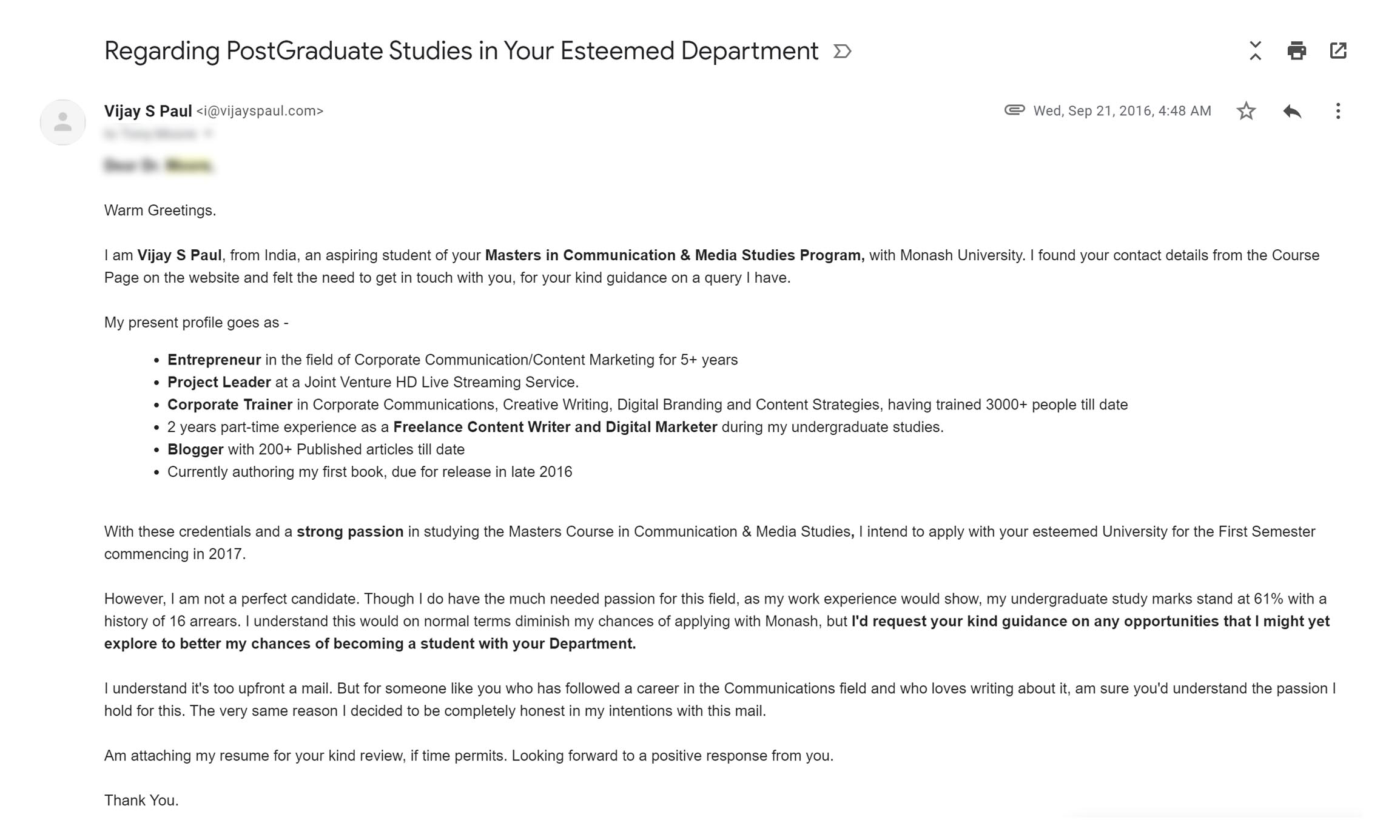Writing a cold email is one of the easiest things ever. But, writing a good cold email is difficult.
Getting a response to one, is heavenly.
Why cold emails are tough
If you have ever written a cold email and tried to get a response from the receiver, you would definitely know that it is difficult for various reasons. One, you have no relationship with them and due to a non-verbal communication method, you cannot respond to them in real-time.
Two, most cold emails are about selling something. Which by default puts off people.
And three, there is no successful formula to crafting the perfect cold email that would get you a favourable response. It’s all trial and error.
Most important thing to remember about cold emailing - there is no successful formula to crafting the perfect cold email that would get you a favourable response. It's all trial and error. Click To TweetMy relationship with cold emails
I have always been an email person. Though it sounds counterintuitive, I personally prefer to email people rather than call them up.
Weird I know. But that’s just who I am.
From 2011 to 2017 when I ran my own service-based startup, I sent out my fair share of cold emails. The majority of them would never get a response. And the majority of those who did respond, said they weren’t interested.
While the rejections did stay in the majority over the years, the number of positive responses did keep increasing gradually.
A lot of it was learning by trial and error. Each time something didn’t work, I’d change an aspect and try again.
A few instances
Throughout my career, there have been a few instances when sending a cold email has made a very high impact. A few instances-
- In 2010, when I started working freelance, the very first client I landed was through a random email I sent them. That person eventually became my business partner years later.
- In 2011, I reached out to a very well-known expert in the field of social media to receive some specific guidance on getting started in the field. He responded positively and to this day, remains a close mentor.
- In 2013, I landed a major client for my startup just by directly emailing the Managing Director of the company. They accounted for more than 30% of our billing for the following financial year.
- In 2016, I was in the process of applying for a master’s degree in communications, with some of the top universities in the world. One of my favourites was Monash University in Melbourne. Even though my work experience was perfect to grant me an admission, my undergraduate scores did not clear the cut-off criteria.
I just emailed the course director a short summary of my profile and reasons as to why I would be the right candidate. Long story short, that email got me an admission into Monash University. Here’s a screenshot of the email I sent to the then course director.
 Looking back, I know I could have made this email better. Oh well, it still got the job done.
Looking back, I know I could have made this email better. Oh well, it still got the job done. - Since 2020, I have been consulting individuals and small businesses on how to write better cold emails. Well, not all of them work, but they almost always work better than the previous emails.
The 8 point guide to writing a cold email
So, getting right to business. From my limited learnings over the years, here are a few suggestions I have on how to write better cold emails.
1. Make the subject line as specific as possible
Instead of having generic titles like “Business opportunity for you”, or “Increase your profit by 200%”, take some time and create personalized, specific subject lines.
One, the person should feel like opening the email. And two, if they do open, they shouldn’t feel cheated by the contrast in the subject and the content of the email.
Don’t overpromise in your subject line and then under-deliver in the content. Be specific and truthful.
2. Validate yourself
Preferably in the very first line, validate yourself.
The reason I say to validate and not introduce is that introduction can be generic and might not serve the purpose at the moment. Validating yourself is about affirming to the person your credentials and the value you bring to the person in having them engage with you.
Don't introduce but rather validate yourself when sending a cold email. An introduction can be generic and might not serve the purpose at the moment. Validation is about your credentials and the value you bring to the person in… Click To TweetFor example, if I am sending a cold email to someone today to offer them my ‘cold emailing consultancy services’, my first sentence would not be:
I am Vijay, an ex-entrepreneur and blogger in the field of communications and content strategy….
This holds no worth for the person reading, in terms of what I am offering them. A much better opening line would be:
I am Vijay, a cold emailing consultant. In the last 4 years, I have helped individuals and small businesses increase their profit by 23% by helping them craft better cold emails…..
3. Keep it short
Keep your emails as short and crisp as possible.
3 short paragraphs are good. But 3 sentences are the best.
4. Keep it personal
Never ever send cold emails as part of a mail merge system, if you actually intend to hear back from people.
The success of a cold email lies in the extent of personalization and personal benefit the reader can perceive out of it. Do your due diligence and spend some time personalizing the email.
The success of a cold email lies in the extent of personalization and personal benefit the reader can perceive out of it. Do your due diligence and spend some time personalizing the email. Click To TweetTry finding a mutual connection or mutual point of interest between you and the receiver. This increases the chances of feeling a personal connection and hence increases the chances of getting a response.
5. What’s in it for them
Apart from the opening statement where you validate yourself, make the rest of the email about them.
What benefit do they get? What’s in it for them?
No one wants to read paragraphs about what you have achieved since kindergarten. They just want to know are you worth their time and how can they benefit.
Just answer that.
6. Have a single easy CTA
The most important part of a cold email is the call to action (CTA).
Are you asking them to read through a 20-page portfolio of yours to take a decision on why you are awesome? Are you offering them 53 services and asking them to contact you if they have any of those needs?
Or are you just asking a simple question to which the answer is an easy yes or no? Something like –
I noticed that your website has a slow loading speed which might be affecting your traffic. I can help you sort out the issue in under 45 minutes. Would you be interested?
Another rule of thumb is letting them know that they are free to decline or say no. 42 different studies have shown that this strategy works most of the time.
7. Make the decision process easy
Along with a simple CTA, present your ‘question’ in such a way that it is easy for the person to make a decision.
Instead of saying-
Are you free to hop on a call when free?
Say something like-
Are you free for a call between 9-11 am on Thursday?
With the first statement, the person has to take the cognitive load of thinking of a day and time when he could be free? This is if they do feel like continuing the conversation with you.
In the second scenario, the decision making is easier. One, the person has a specific time of reference which makes it easy for them to decide if they are available or not. Two, even if they say no, you get a response, to which you can then offer alternatives.
8. Show gratitude
While I always make sure that ‘all’ my emails have a sense of gratitude, it is particularly helpful if your cold emails do. In fact, studies show that being appreciative and thankful doubles the responses!
Thank you for reading through!
I invite you to join my small but awesome community. Just drop in your email below and I’ll send you awesome content every week.
Photo by Lieve Ransijn on Unsplash



